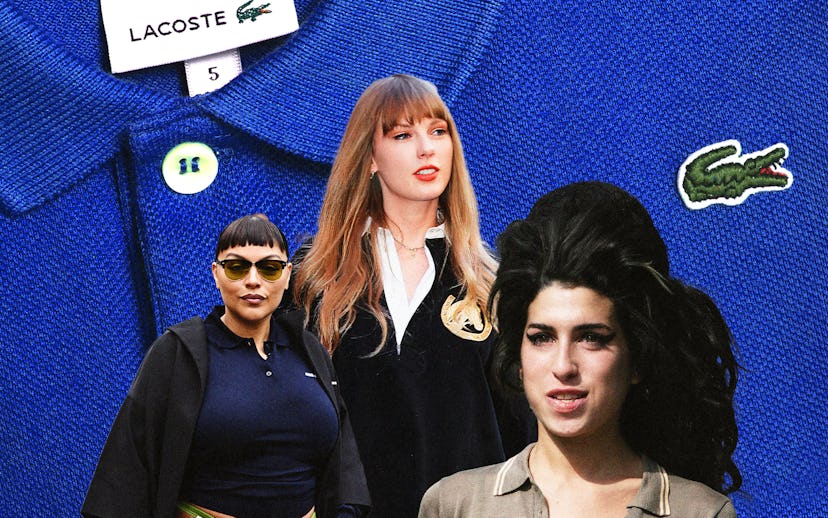
From The Magazine
The Polo Is Back (Again) — But This Time With A Whole Different Meaning
“For anyone who’s paying attention, this is a garment that sends a message.”
In October, when Miuccia Prada sent models wearing polo shirts down Miu Miu’s Spring 2024 runway, I was instantly hurtled back to the early 2000s when I attended a prep school with a strict dress code. For me, the style is a potent symbol of that awkward, socially charged time — one that I’d kind of like to forget. But as Maggie Bullock writes in her book, The Kingdom of Prep, the polo is like a bad guy in a horror movie: No matter how hard anyone tries to kill it, it simply will not die.
“It’s never not back,” says Bullock today. In fact, such are the lurching fortunes of the polo that Vogue has declared the shirt “back” basically every two years since 2016. This teetering return to form probably has something to do with the fact that the polo is freighted with more meaning than your average button-down. “The polo is never just clothes,” says Bullock. “For anyone who’s paying attention, this is a garment that sends a message.” In recent years, that message has been polarizing. “When it goes out of style, it really goes out — it’s like a Proud Boys uniform,” Bullock adds. “But when it is in style, it’s fresh! It’s classically American! It’s sporty and youthful!”
According to Lisa Birnbach, coauthor of The Official Preppy Handbook and True Prep, it all started about 100 years ago with Monsieur René Lacoste, or “Le Crocodile,” who brought the shirt off the tennis court and into the hands of the “preppies.” In 1980, The Preppy Handbook declared the brand the “sport shirt of choice,” noting, “Only the all-cotton model will do, the one with cap sleeves with the ribbed edging, narrow collar, and two-button placket (never buttoned).” But nothing lasts forever, and eventually, Le Crocodile would meet its match in a little polo man. Ralph Lauren’s version, introduced in 1972, came in an array of fresh colors that may not have seemed suitable for the court, and introduced the aspirational look to those beyond the country-club set. According to Bullock, Polo even sold a “pre-worn” version, as to give the impression that you were to the manor born — or that you’d been wearing the cotton shirt your whole life.
Yet for such a traditional item of clothing, the polo shirt has always been a shape-shifter. In the early ’90s, for example, the polo shirt found a broader audience with the Lo Lifes, a group of Black and Latino Polo enthusiasts in New York, who made it their own. Kanye West and other hip-hop artists in the early 2000s also adopted the style. Author Danielle Prescod, who grew up wearing polos at a Connecticut prep school, recalls how West changed the game. “It introduced a new way of wearing that style,” she says. “It was like, ‘Oh, men can wear a pastel pink shirt, and it’s a polo.’ And if you style it with a chain and a pair of Gucci pants and a belt, it’s cool.”
Today’s polo shirt — showing up in movies like Challengers (hot), television shows like Ripley (scary), and, of course, all over pickleball courts (OK, dad) — is different. A-list celebrities like Taylor Swift, Hailey Bieber, and Gigi Hadid are wearing them extra-cropped, extra-large, and sometimes as a minidress. This new polo isn’t sleazy in a Chuck Bass way, or punk in an Amy Winehouse way, or even ironic in the “normcore” golf dad way. It’s just rich. In many cases, it’s more than $1,000, with high-fashion credentials. (Dries Van Noten, Loewe, The Row, and Gucci put out versions this year.)
“To me, it’s a meeting of maximalism and ‘stealth wealth,’” says fashion writer and consultant Laurel Pantin. “It’s somewhere in the middle zone, where there’s a layer of the old-school wealth that isn’t so Succession — it’s a bit more youthful.” Today’s “quiet luxury” edition, which is logo-less and made of a material more expensive than cotton, marks a return to the style’s bourgeoisie DNA without being so in-your-face about it.
Is it possible to strip the polo down to its essential parts and give it a fresh start? Probably not, no matter how hard The Row tries. The polo shirt’s irrepressible appeal surely has something to do with the fact that it’s a rare fashion twofer: It’s smart and comfortable. “It’s almost like a T-shirt,” says fashion writer Tyler McCall, who remembers attempting to bring the Upper East Side look to her college town in Gainesville, Florida, during its Gossip Girl heyday. “But a little bit more elevated.” (On the day I spoke to McCall, she was wearing a polo — not too baggy, not too fitted — with a relaxed pair of corduroy pants.)
Pantin, meanwhile, loves her High Sport polo for its Italian-made material (“just the right thickness”), colors (“slightly off” with a bit of worn-in “sun-bleached quality”), and no logo. Prescod, however, is wearing polos only as they were originally intended: to go horseback riding.
There’s a case to be made that this tilt at elevation is more exciting in a post-pandemic world. Millennials were already wearing sweatpants and crop tops to the office, but WFH pushed most of us into full athleisure. Now that we’re back outside, the promise of the polo — elevated but easy, evergreen but modern — feels appealing. Perhaps it’s the functionality that’s making this comeback stickier. After all, as Birnbach says, the fundamental appeal is casual polish. “It’s not about, Do you look like you went to Hotchkiss?” she says. “It’s about, Are you sure you want to wear no collar?”